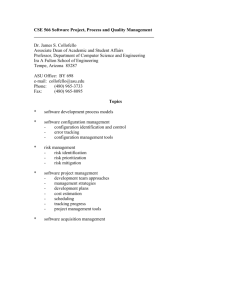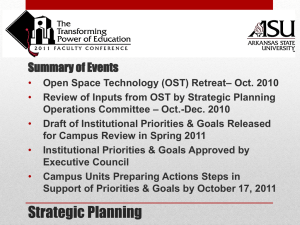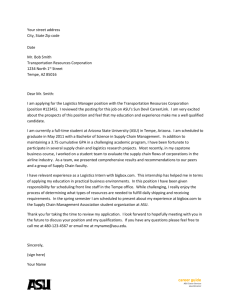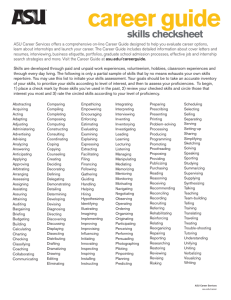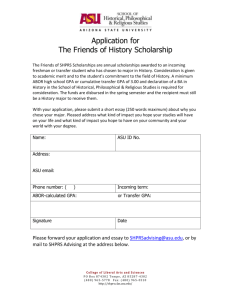Powerpoint - Arizona State University
advertisement
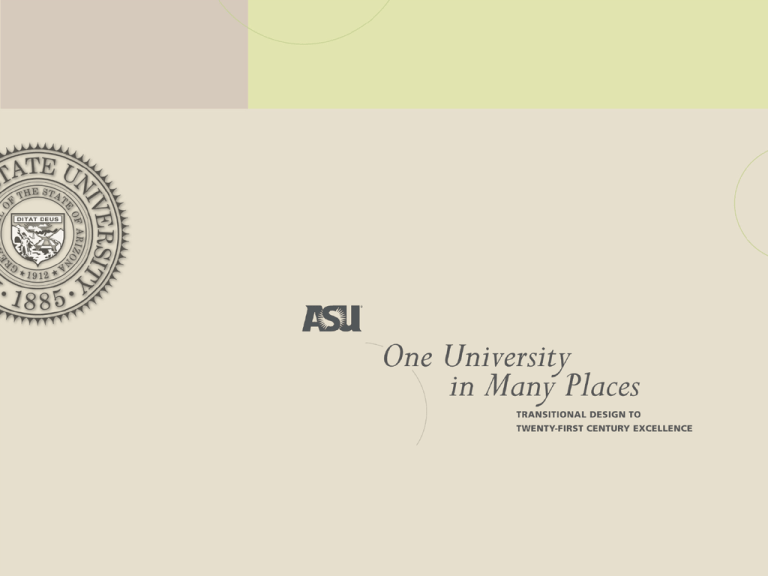
OBJECTIVE OF THE DESIGN PROCESS To build a comprehensive metropolitan university that is an unparalleled combination of academic excellence and commitment to its social, economic, cultural, and environmental setting ASU VISION To establish ASU as the model for a New American University, measured not by who we exclude, but rather by who we include; pursuing research and discovery that considers the public good; assuming major responsibility for the economic, social, and cultural vitality of its community. DESIGN IMPERATIVES FOR A NEW AMERICAN UNIVERSITY Leveraging place Embracing our cultural, social, economic, and physical setting Transforming Society Becoming a force, and not only a place Academic Enterprise Serving as a responsible knowledge entrepreneur Use-Inspired Research Improving the human condition through the appropriate application of knowledge Focus on the Individual Outcome-determined excellence; commitment to intellectual and cultural diversity Intellectual Fusion Interdisciplinary / multidisciplinary / transdisciplinary / postdisciplinary Social Embeddedness Social enterprise development through direct engagement Global Engagement Transnational / transcultural focus CHALLENGES CONFRONTING ASU • Explosive population growth • Increasing demographic diversification • Limited higher education infrastructure • Underperforming pre-K–20 educational system • Physical constraints on the Tempe campus • Limited public and private support • Increased global competition EVOLUTION OF ASU 1885–1925 1925–1945 1945–1958 1958– 1994 2002– 2012– Territorial Normal School Arizona State Teachers College Arizona State College Arizona State University Carnegie Foundation “Research I” status A strong regional university with focused strengths ASU as the New American University (One of the nation’s premier research universities) ASU DESIGN OPTIONS Replication model Attempt to reproduce successful public metropolitan research universities (UCLA, University of Washington, University of Texas, Austin) Incremental model (trajectory model) Linear extrapolation based on trajectory of existing institution Differentiation model Establish ASU as the model for a “New American University” Redefine the American research university DIFFERENTIATION MODEL Build on existing ASU strengths to produce: • An institution focused on teaching, research, creative excellence; • A flexible, responsive, problem-focused institution; • An institution concerned with optimal societal outcomes of research; • A cooperative environment with student, faculty, staff in pursuit of excellence; • Strong and deep linkages to the community; • Distribution of programs throughout the community; • Nationally competitive interdisciplinary traditions; • Unique colleges, schools, interdisciplinary research centers, and departments (“school-centrism”) ONE UNIVERSITY IN MANY PLACES Although a single and unified institution, ASU is spatially distributed across metropolitan Phoenix in four differentiated campuses of equally high aspiration: • ASU at the Tempe campus • ASU at the West campus • ASU at the Polytechnic campus • ASU at the Downtown Phoenix campus Each campus represents a planned clustering of related colleges and schools SCHOOL-CENTRISM • A federation of unique colleges, schools, academic departments, and interdisciplinary institutes and centers (“schools”); • A deliberate and planned clustering of programs on each campus around a related theme and mission; • Schools develop unique intellectual identities within ASU (complementary, i.e., no duplication); • University success driven by success of schools competing at highest levels SCHOOL-CENTRISM: COMPETITION • Schools compete for status, not with other schools within the university, but with peer schools around the country and around the world (targeted competitors); • Schools grow and prosper to the extent of their individual intellectual and market limits (school-specific metrics for success); • Each school competes for top faculty, students, and resources; • Competition is enhanced by close-knit organizations with focused missions and high degrees of freedom SCHOOL-CENTRISM: EMPOWERMENT • Intellectual and entrepreneurial responsibility devolves to the level of the college or school; • Schools overcome historical intellectual and fiscal constraints through school-level ownership; • Deans assume fiscal as well as academic responsibility; • Schools are encouraged to develop new designs and directions to attain differentiation and distinction, both within ASU and among peers SCHOOL-CENTRISM: CONCEPTUALIZATION AND DESIGN EXISTING COLLEGES SCHOOLS • • • • Incremental changes following review and planning; New conceptions, new directions, new models; New facilities for many; New and differentiated names REDESIGNED AND NEW COLLEGES AND SCHOOLS • Interdisciplinary / transdisciplinary / intellectual fusion SCHOOL-CENTRISM: CONCEPTUALIZATION AND DESIGN EXAMPLES OF NEW COLLEGES / SCHOOLS / INSTITUTES • • • • • • Biodesign Institute (Tempe campus) School of Life Sciences (Tempe campus) School of Criminal Justice and Criminology (West campus) College of Management (Polytechnic campus) University College (Downtown campus) School of Human Evolution and Social Change (Tempe campus) SCHOOL-CENTRISM: IMPLEMENTATION PHASE 0 DESIGN AND PLANNING 2004–2006 (1–2 years, depending on program) PHASE 1 IMPLEMENTATION 2005–2009 (2–4 years, depending on programs and facility requirements) PHASE 2 INTEGRATION AND LINKAGE 2007–2012 (3–5 years, depending on program) By 2012 ASU will be on track to become one of the nation’s leading public metropolitan research universities. SUMMARY: TEMPE CAMPUS • • • • • • • • College of Liberal Arts and Sciences Barrett Honors College College of Architecture and Environmental Design W. P. Carey School of Business College of Education Ira A. Fulton School of Engineering Katherine K. Herberger College of Fine Arts College of Law Recommendations include: • College of Architecture and Environmental Design will offer select programs to students on other campuses; • The Herberger College of Fine Arts will develop an arts presence on the Downtown Phoenix campus and on the Polytechnic campus; • The Del E. Webb School of Construction will offer a construction management program on the Tempe campus, and a construction technology program on the Polytechnic campus SUMMARY: POLYTECHNIC CAMPUS • • • • • College of Management College of Technology and Applied Sciences School of Health Professions School of Education Professions College of Arts, Sciences, and Humanities Recommendations include: • College of Technology and Applied Sciences moves to top 5–7 nationally • Development of a general engineering program • Development of College of Management • Physical education program relocates from Tempe campus • Del E. Webb School of Construction offers construction technology program SUMMARY: WEST CAMPUS • • • • New College of Interdisciplinary Arts and Sciences College of Human Services College of Teacher Education and Leadership School of Global Management and Leadership Recommendations include: • Development of School of Criminal Justice and Criminology • Enhancement of Program in Recreation and Tourism Management SUMMARY: DOWNTOWN PHOENIX CAMPUS Moving to the new Downtown Phoenix campus: • College of Nursing • College of Public Programs - School of Public Affairs - School of Community Resources and Development - School of Social Work - Morrison Institute for Public Policy • Walter Cronkite School of Journalism • KAET-TV Channel 8 (Arizona PBS) • School of Global Health • University College - School of Interdisciplinary Studies - Extended Education - Academic Advising - Community College Relations - Success and Engagement Programs ASU Vision and University Goals 2002-2012 (01/05/06) ASU Vision and University Goals 2002-2012 (08/03/05) ASU Vision and University Goals 2002-2012 (08/03/05) ASU Vision and University Goals 2002-2012 (01/05/06) ASU Vision and University Goals 2002-2012 (08/03/05) 8/03/05
